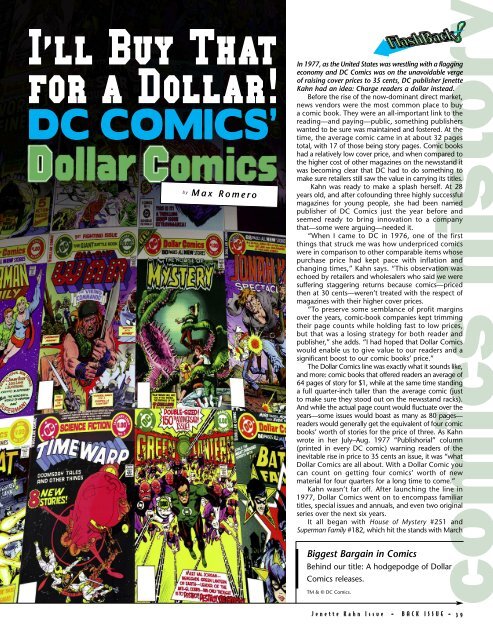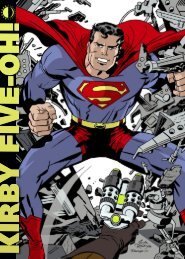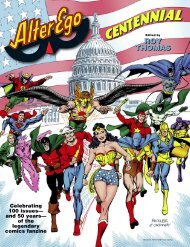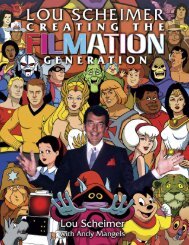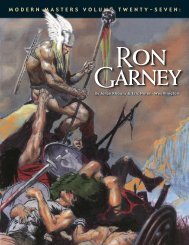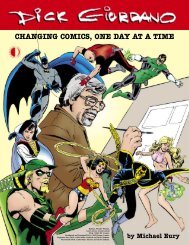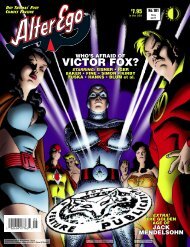JENETTE KAHN - TwoMorrows Publishing Store
JENETTE KAHN - TwoMorrows Publishing Store
JENETTE KAHN - TwoMorrows Publishing Store
Create successful ePaper yourself
Turn your PDF publications into a flip-book with our unique Google optimized e-Paper software.
y M a x R o m e r o<br />
In 1977, as the United States was wrestling with a flagging<br />
economy and DC Comics was on the unavoidable verge<br />
of raising cover prices to 35 cents, DC publisher Jenette<br />
Kahn had an idea: Charge readers a dollar instead.<br />
Before the rise of the now-dominant direct market,<br />
news vendors were the most common place to buy<br />
a comic book. They were an all-important link to the<br />
reading—and paying—public, something publishers<br />
wanted to be sure was maintained and fostered. At the<br />
time, the average comic came in at about 32 pages<br />
total, with 17 of those being story pages. Comic books<br />
had a relatively low cover price, and when compared to<br />
the higher cost of other magazines on the newsstand it<br />
was becoming clear that DC had to do something to<br />
make sure retailers still saw the value in carrying its titles.<br />
Kahn was ready to make a splash herself. At 28<br />
years old, and after cofounding three highly successful<br />
magazines for young people, she had been named<br />
publisher of DC Comics just the year before and<br />
seemed ready to bring innovation to a company<br />
that—some were arguing—needed it.<br />
“When I came to DC in 1976, one of the first<br />
things that struck me was how underpriced comics<br />
were in comparison to other comparable items whose<br />
purchase price had kept pace with inflation and<br />
changing times,” Kahn says. “This observation was<br />
echoed by retailers and wholesalers who said we were<br />
suffering staggering returns because comics—priced<br />
then at 30 cents—weren’t treated with the respect of<br />
magazines with their higher cover prices.<br />
“To preserve some semblance of profit margins<br />
over the years, comic-book companies kept trimming<br />
their page counts while holding fast to low prices,<br />
but that was a losing strategy for both reader and<br />
publisher,” she adds. “I had hoped that Dollar Comics<br />
would enable us to give value to our readers and a<br />
significant boost to our comic books’ price.”<br />
The Dollar Comics line was exactly what it sounds like,<br />
and more: comic books that offered readers an average of<br />
64 pages of story for $1, while at the same time standing<br />
a full quarter-inch taller than the average comic (just<br />
to make sure they stood out on the newsstand racks).<br />
And while the actual page count would fluctuate over the<br />
years—some issues would boast as many as 80 pages—<br />
readers would generally get the equivalent of four comic<br />
books’ worth of stories for the price of three. As Kahn<br />
wrote in her July–Aug. 1977 “Publishorial” column<br />
(printed in every DC comic) warning readers of the<br />
inevitable rise in price to 35 cents an issue, it was “what<br />
Dollar Comics are all about. With a Dollar Comic you<br />
can count on getting four comics’ worth of new<br />
material for four quarters for a long time to come.”<br />
Kahn wasn’t far off. After launching the line in<br />
1977, Dollar Comics went on to encompass familiar<br />
titles, special issues and annuals, and even two original<br />
series over the next six years.<br />
It all began with House of Mystery #251 and<br />
Superman Family #182, which hit the stands with March<br />
Biggest Bargain in Comics<br />
Behind our title: A hodgepodge of Dollar<br />
Comics releases.<br />
TM & © DC Comics.<br />
J e n e t t e K a h n I s s u e • B A C K I S S U E • 3 9


